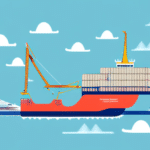Understanding FOB Shipping Point
FOB stands for “Free on Board,” a term used in shipping agreements to define when ownership and responsibility of goods transfer from the seller to the buyer. Specifically, FOB Shipping Point (also known as FOB Origin) means that the buyer assumes ownership and responsibility for the goods as soon as they are loaded onto the carrier at the seller’s location. This distinction is crucial in determining who bears the costs and risks associated with the transportation of goods.
FOB Shipping Point vs. FOB Destination
It is important to differentiate between FOB Shipping Point and FOB Destination. While FOB Shipping Point transfers ownership to the buyer at the point of origin, FOB Destination means that the seller retains ownership until the goods reach the buyer’s location. This difference affects who is responsible for shipping costs and who bears the risk of loss or damage during transit.
Responsibilities of Buyers and Sellers
Seller’s Responsibilities
Under FOB Shipping Point terms, the seller is responsible for:
- Loading the goods onto the carrier.
- Providing necessary documentation for the shipment.
- Ensuring the goods are properly packaged and labeled.
Once the goods are loaded, the seller’s responsibility ends, and the buyer takes over all subsequent duties.
Buyer’s Responsibilities
The buyer assumes responsibility for:
- Freight charges from the shipping point to the final destination.
- Insurance during transit.
- Handling any damages or losses that occur during transportation.
- Coordinating with freight forwarders or logistics providers.
Determining Freight Payment in FOB Shipping Point
Typically, in an FOB Shipping Point agreement, the buyer is responsible for all freight charges. However, this can be negotiated between the buyer and seller based on the specifics of the transaction.
Factors Affecting Freight Costs
Several factors influence who ultimately pays the freight charges:
- Distance: Longer distances generally result in higher transportation costs.
- Type of Goods: Perishable or fragile items may require specialized handling, increasing costs.
- Mode of Transport: Different transportation methods (air, sea, road) have varying cost structures.
- Volume and Weight: Heavier and bulkier shipments typically cost more to transport.
Transportation Modes and Their Impact
Air Freight
Air freight is the fastest mode of transportation but also the most expensive. It's ideal for high-value or time-sensitive goods. For example, according to the International Air Transport Association (IATA), air freight costs can be up to 5 times higher than sea freight.
Sea Freight
Sea freight is more cost-effective for large and heavy shipments, making it suitable for industries like manufacturing and wholesale. However, it has a longer transit time. The average transit time from China to the United States by sea is approximately 20-30 days.
Road Freight
Road freight offers flexibility and is often used for domestic shipments or when the final destination is not accessible by sea or air. It is generally more affordable than air freight but can be subject to delays due to traffic or weather conditions.
Pros and Cons of FOB Shipping Point
Advantages for Buyers
- Greater control over the shipping process and choice of carrier.
- Potential cost savings by negotiating directly with freight providers.
- Flexibility in managing delivery schedules and logistics.
Advantages for Sellers
- Reduced financial and logistical burden once goods are shipped.
- Lower risk of loss or damage during transport.
- Simplified sales process without managing transportation.
Disadvantages
- Buyers bear the risk of loss or damage during transit.
- Sellers may have less control over the shipment once it’s delivered to the carrier.
- Potential for disputes if responsibilities are not clearly defined.
Negotiating Freight Costs
Effective negotiation can lead to significant savings in freight costs. Here are some strategies:
Compare Multiple Carriers
Obtaining quotes from several carriers can help identify the most cost-effective option. Utilize platforms like ShipScience to compare rates and services.
Optimize Packaging
Reducing the weight and volume of shipments can lower transportation costs. Efficient packaging minimizes space and material usage, contributing to cost savings.
Consolidate Shipments
Combining smaller shipments into a larger one can reduce per-unit shipping costs. This strategy is particularly effective for buyers with regular or bulk orders.
Legal Implications and Avoiding Disputes
Legal Considerations
FOB Shipping Point agreements are legally binding. It is essential to have a clear contract that outlines the responsibilities and obligations of both parties to prevent legal disputes.
Best Practices to Avoid Disputes
- Clear Communication: Ensure all terms are clearly defined and understood by both parties.
- Detailed Documentation: Keep thorough records of all transactions, agreements, and communications.
- Consult Legal Professionals: Seek legal advice to ensure agreements comply with relevant laws and regulations.
Common Misconceptions about FOB Shipping Point
Several misconceptions exist regarding FOB Shipping Point:
- Immediate Responsibility: Some believe the buyer is responsible as soon as the seller signs the contract, but responsibility only transfers once goods are loaded onto the carrier.
- Seller Pays All Costs: Contrary to belief, the seller only covers costs up to the shipping point, not the entire transportation journey.
Understanding these nuances is crucial for both buyers and sellers to avoid misunderstandings and ensure smooth transactions.
Best Practices for Managing Freight in FOB Shipping Points
- Select Reliable Carriers: Choose carriers with proven track records for reliability and safety.
- Negotiate Favorable Terms: Discuss rates, delivery times, and insurance options upfront.
- Monitor Shipments: Use tracking systems to stay informed about the status of shipments.
- Maintain Open Communication: Keep lines of communication open between buyers, sellers, and carriers to address any issues promptly.
Case Studies: Real-life Examples of Freight Payment in FOB Shipping Points
Real-life examples highlight the importance of clear FOB Shipping Point agreements:
Case Study 1: Manufacturer and Retailer Agreement
A manufacturer agreed to FOB Shipping Point terms with a retailer. The retailer chose a cost-effective carrier, resulting in lower freight costs. However, improper packaging led to damaged goods during transit, causing the retailer to incur additional costs for replacements. This scenario underscores the importance of proper packaging and selecting reliable carriers.
Case Study 2: International Trade Partnership
An international trade partnership utilized FOB Shipping Point for shipments from China to the United States. By negotiating bulk shipping rates and consolidating shipments, both parties achieved significant cost savings. Effective communication and clear contractual terms ensured a smooth transaction, demonstrating the benefits of strategic negotiation and planning.
In conclusion, FOB Shipping Point is a valuable shipping arrangement that offers benefits to both buyers and sellers. Understanding the responsibilities, effectively negotiating freight costs, and adhering to best practices can lead to successful and cost-efficient transactions.






















